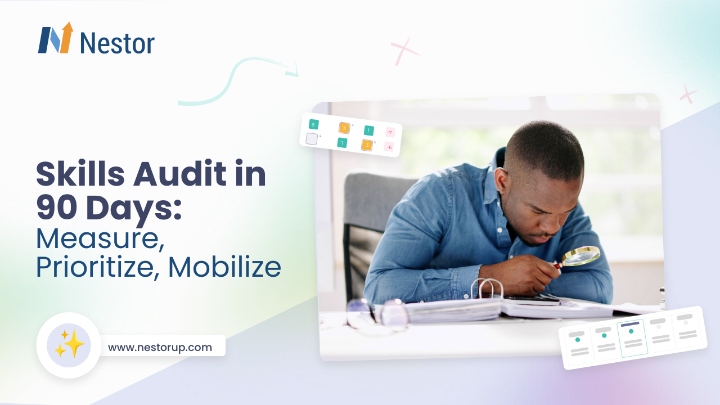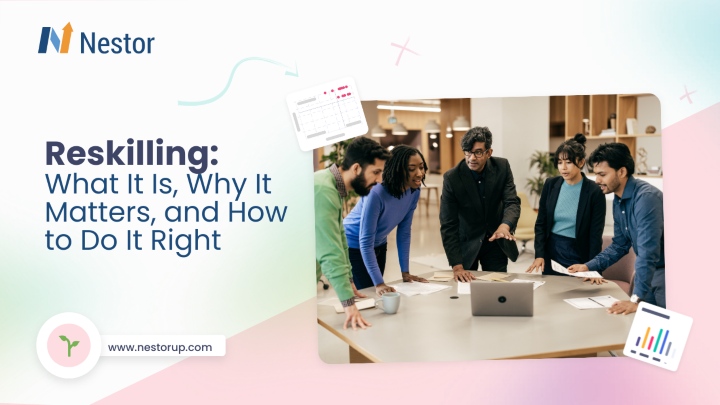Tracking Skill Development with Growth Plans and Performance Reviews
11 min read

Contents
Keeping up with the rapidly changing needs associated with the accelerated adoption of new technologies and the new dynamic nature of work is no longer a matter of choice — which is why skill development has become more relevant and important than ever before.
Companies cannot afford to maintain employees with obsolete skills, especially since a potential mismatch between skills and the expectations of a job role can influence an employee’s achievements and the company’s overall productivity.
Therefore, developing the abilities and knowledge of employees has become an absolute must for organizations that want to future-proof their workforce and ensure they have the right skills to succeed, both today and tomorrow.
In the first part of this article, we talk about the role and importance of skill development in modern workplaces. We then take a closer look at how growth plans and performance reviews can help HR and people leaders track and support their skill development initiatives. Let’s dive right in!
What is skill development?
Skill development is the process of systematically refining and improving existing abilities or acquiring new ones.
Organizations that embrace it aim to help their employees become more proficient, meet the performance expectations of a specific job role, or qualify for the next stage of their career, in the form of either vertical or lateral moves. People who participate in skill development programs can target both technical and soft skills.
Developing new skills can take various forms but usually involves going through sessions of learning, training, and practicing the new desirable skills and proficiency levels.
Skill development is essentially one of the parts or components of the broader skills management process, through which modern companies aim to enhance the potential of their workforce.
Why is skill development important?
Skill development is not only important, but a necessity in a world of work where the half-life of skills is now around 5 years.
It’s enough to look at job descriptions from 2017 or 2018 to understand how fast and how much skill and business needs have changed in such a short period. And this trend will only accelerate with the adoption of AI, robotic solutions, and automation in general.
This entire situation makes the benefits and impact of skill development even more significant for all parties (employers and employees) who want to remain relevant and still provide value in a changing world:
- Improved productivity and efficiency: Regularly updating the capabilities and know-how of workers is the best way to ensure they make better use of the available resources and tools to move the company forward.
- Higher retention rates: Investing in the growth and development of your people will not only make them perform better but will also increase engagement and satisfaction levels, determining them to have longer tenures at your company. This is especially important for Gen Z employees.
- Rapid innovation: By diversifying and refining their skills, people will have a better understanding of work and business processes and will be better positioned to generate innovative ideas and come up with ground-breaking discoveries.
- Business continuity and agility in the face of disruptions: We’ve already highlighted how embracing and supporting skill development will help engage and retain talent longer. But this process has also the power to boost succession planning and proactively identify and prepare employees for leadership and other key roles, future-proofing the organization against unexpected departures or retirements.
- Outpacing competitors: As the workplace of tomorrow will be defined by skills-based approaches and skills in general (especially, soft ones), companies that invest early in learning and development programs will reap the rewards of having and attracting a highly skilled workforce — placing themselves ahead of the competition and at the forefront of innovation.
Use performance reviews to identify skill development needs and areas for improvement
To ensure that an organization remains on track and makes progress toward business objectives, leaders and decision-makers need to check on a regular basis that people in critical roles are performing as expected and have (or develop) the skills required to succeed.
When it comes to evaluating employee skills and identifying the most urgent improvement areas or skill gaps that should be addressed, performance reviews are the best place to start in that direction.
In our opinion, modern performance reviews have two goals: an accurate and actionable evaluation of performance goals followed by the development of that person’s skills in line with job expectations.
The performance review process involves assessing skills against performance expectations, starting with identifying the employee’s necessary skills aligned with company objectives. Then, employees engage in self-evaluation to foster self-awareness, followed by managers providing detailed assessments based on observations and workplace performance examples. The process culminates in discussing the insights from skill assessments to create a personalized growth plan for the next review period.
These performance reviews or appraisals usually take place every 6 or 12 months. However, some companies can conduct them quarterly, depending on their policies. Such a review should end with a future-oriented discussion on a growth plan for the next period. Here, both the manager and the employee should agree upon:
- The next performance and learning objectives (skill development)
- Clear actions to be taken to achieve the individual (and/or team) KPIs
- Clear actions to be taken to develop specific skills
- The learning outcomes and evaluation methods
- The resources or support required for the growth plan to be successful
How to set up growth plans focused on skill development
A growth plan — also referred to as a professional or employee development plan — is essentially a structured and strategic way through which companies support the development of their employees. As a result, employees can improve their knowledge in a specific subject or their ability in a specific skill.
This type of plan consists of outlining clear goals, specifying development actions, and establishing the methods used to track and evaluate progress over time. A key aspect of growth plans is aligning the career aspirations of each person with the needs of the company.
The organized and goal-based nature of growth plans has the power to transform skill development into a process that’s easier to manage, track, or adjust if necessary.
Learn more about skills-based employee development plans.
Establish the scope of the growth plan
Growth plans can serve multiple purposes and shouldn’t be limited to improving performance.
In the case of succession planning, for example, the plan would focus more on developing the soft and leadership skills of internal candidates to prepare them for future roles in key strategic positions.
In the case of fresh hires, a growth plan can act as a roadmap, guiding them through the onboarding process and helping them acclimatize to the company culture faster and meet the expectations associated with their probationary period.
Here’s how starting a new growth plan looks in Nestor, our People Intelligence Platform:
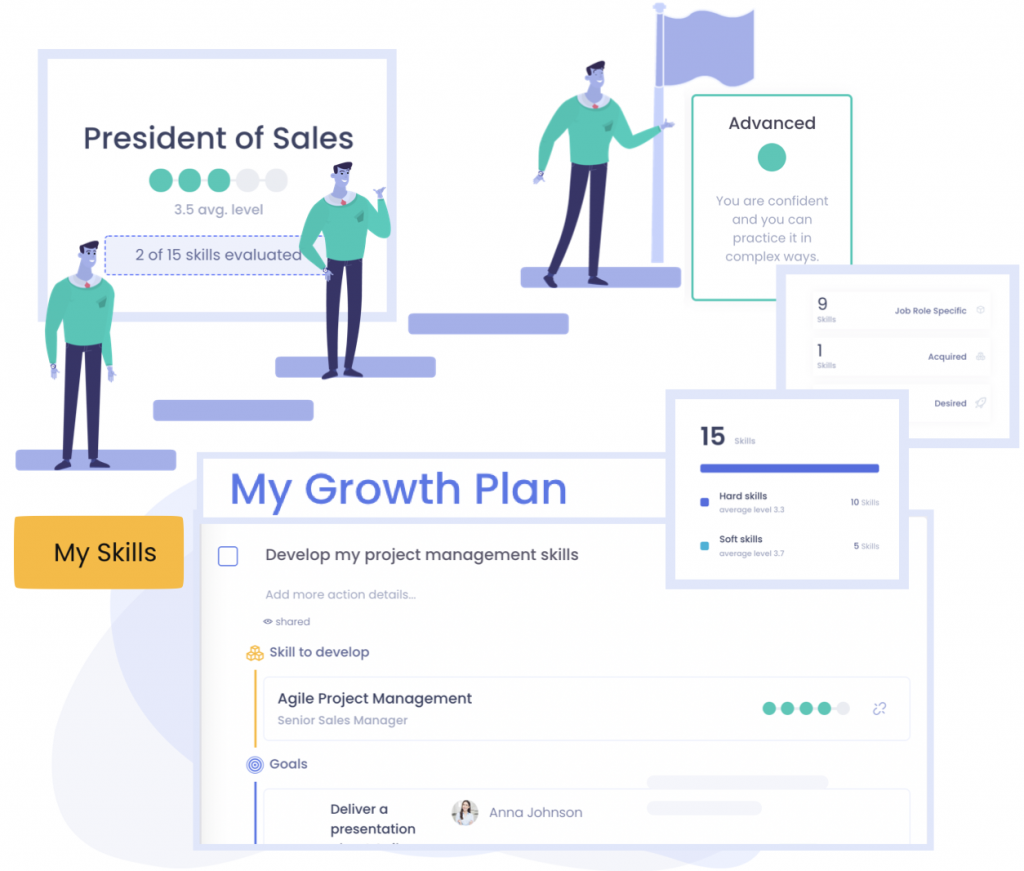
Assign and align learning objectives and development actions with skills
Each employee can be assigned one or multiple actions to enhance a specific skill. But while multiple learning objectives can be listed, it’s important to focus skill development on areas with the highest ROI while balancing day-to-day tasks with learning activities.
Let’s take a close look at some examples from our platform:
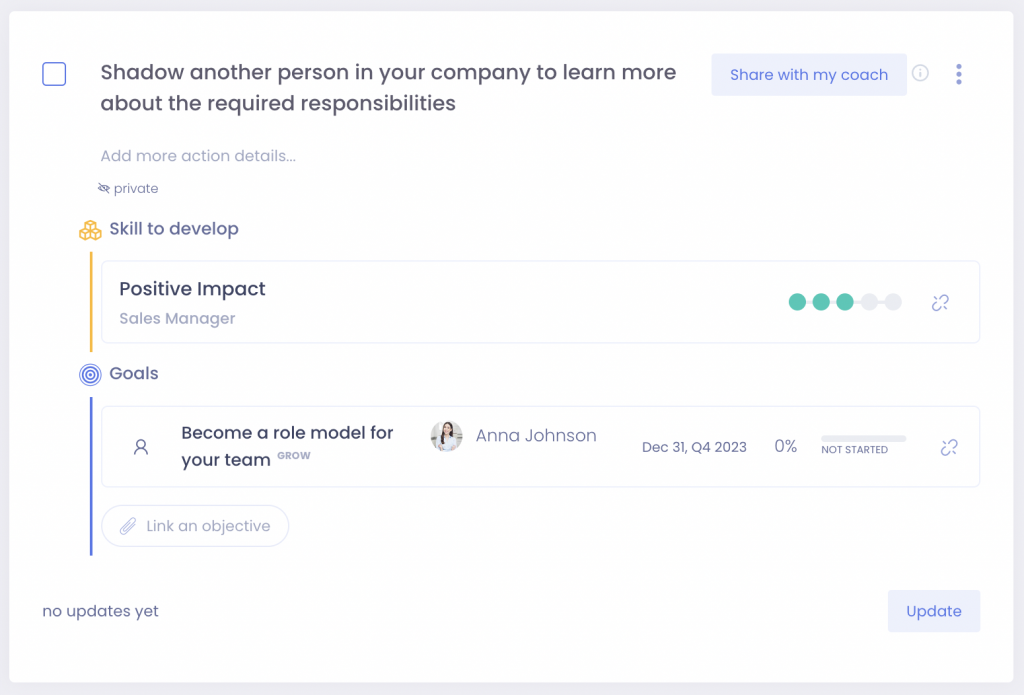
Our skill rating system has 5 levels (1-5): aware of, beginner, familiar with, proficient, and advanced. Here, you can see that the goal Anna (made-up employee) established with her manager is to become a role model within her team.
However, her ability to have a positive impact is currently limited at level 3: familiar with. Therefore, as part of her growth plan, she aims to take this skill to the next level — proficient. At the manager’s suggestion, she agreed that shadowing another colleague would be an effective and engaging way to reach this goal.
As we’ve mentioned earlier, multiple skill development goals and actions can be set:
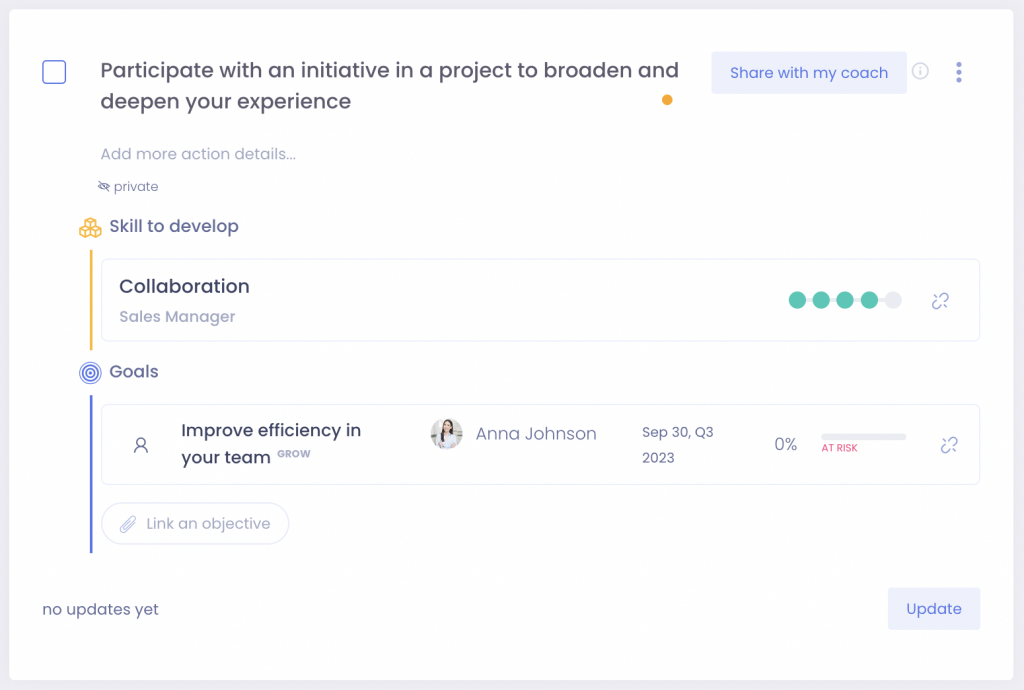
Here, we’re looking at the same person and growth plan, just a different goal and action.
To become even more efficient in her team (goal), Anna will seek to bring a personal initiative to a project (action) and, in the process, take her ability to collaborate with others (skill) to level 5: advanced.
As you can see, an essential part of using growth plans to support skill development is aligning learning goals with individual skills. But just as important is having awareness of the current proficiency level of that skill and the next desirable level that needs to be reached as part of the plan.
Without these alignments and clear skill data, growth plans won’t be specific enough and will not have the expected results, because they will fail to follow the S.M.A.R.T goal formula:
- Specific: Skill development goals should be clear and very specific (use proficiency levels)
- Measurable: Ensure progress and outcomes can be tracked and assessed
- Achievable: Together with the employee, focus on goals that can be reached before the next performance review
- Relevant: To have relevancy, skill development goals need to align employee and business needs
- Time-based: Learning objectives should have clear deadlines that are mutually agreed upon during the initial performance evaluation
How to track skill development
Performance reviews
After a 3, 6, or 12-month period has passed, the next performance review will enable managers and decision-makers to assess the (degree of) success of the growth plan created previously.
Since the focus is on skill development, the evaluation will look at how an employee performs using the skills required for their job role. The aim of the performance review is to check the new level of the skill targeted for development and establish if it has evolved (and to what degree). This is done for each skill development or learning objective agreed upon and set in the growth plan.
After the evaluation takes place and data-driven insights are drawn, the process starts again and a new growth plan is born using the steps we’ve highlighted earlier.
Self-assessment
Through self-assessments, you can empower employees to rate their skills and knowledge for themselves. A self-assessment is a great tool to use because it approaches the skills inventory from a self-perspective. Employees can also express which skills they want to work on improving.
Skill matrices
Skill matrices are visual and effective representations of employee skills and proficiency levels, most often encountered as grids or charts. Skill matrices help managers visualize the skill distribution in their teams.
On one axis, you’ll find the list of skills associated with a given role or with an employee, and on the other axis are listed proficiency levels, which can differ from one organization to another.
Skills management software or platforms include this type of handy tool to allow managers access to real-time and easy-to-understand skill data. This is how a skill matrix looks in Nestor:
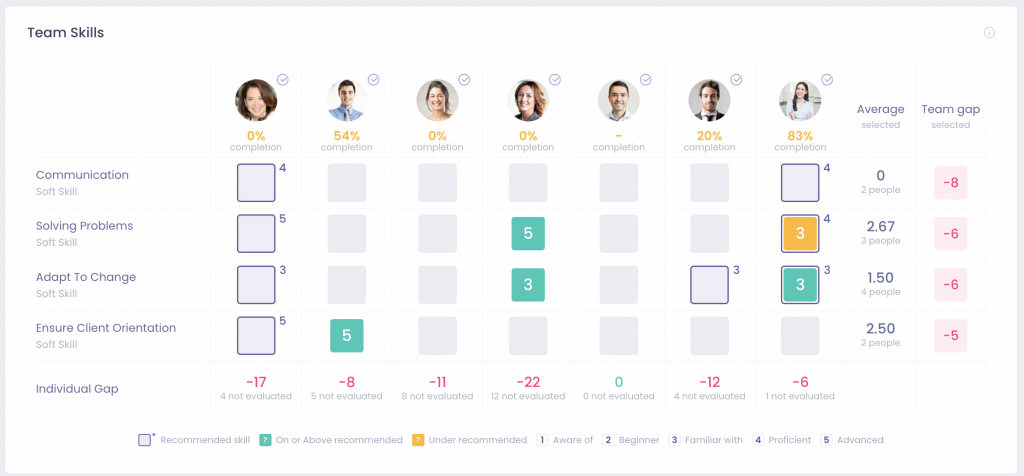
As you can see in our example, the visual representation not only simplifies things but also reveals additional insights, like whether the current proficiency level of a given skill is above or under the recommended level for the employee’s role or for the team’s needs.
In this particular situation, Anna may be familiar with problem-solving (level 3), but she still has some work to do to reach level 4, which is the proficiency required for her role.
Final thoughts
In today’s world of work, skill development has become the key to unlocking the full potential of both employees and companies.
As managers and L&D specialists, it’s important to recognize that supporting and facilitating skill development isn’t just a strategic move — it’s also a commitment to nurturing resilient and future-proof workforces.
With Nestor, our People Intelligence Platform, companies can align entire processes, from performance management and employee engagement to career development through a single source of truth: skills.
Schedule a free demo to learn how our predictive analytics and nudging automation will empower your talented employees to take ownership of their careers and access best-fit skill development opportunities.







